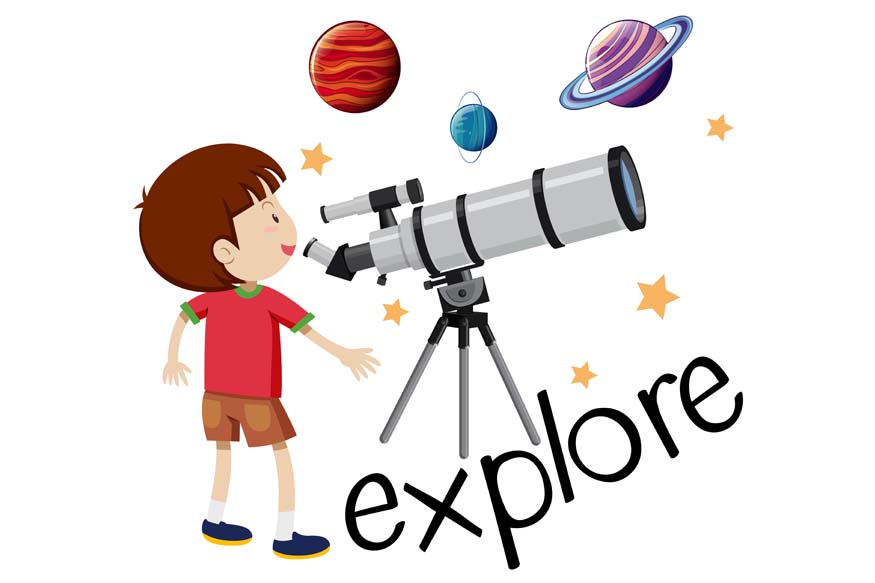Have you ever wondered what those twinkling lights in the night sky are? Have you dreamt of exploring distant planets and galaxies? If so, you have probably imagined using a telescope! Telescopes are fascinating instruments that allow us to see far beyond what our eyes can perceive. In this article, we will dive into what a telescope is, how it works, and why it is such an important tool for both scientists and curious minds like yours.
What is a Telescope?
A telescope is an optical instrument designed to make distant objects appear closer and more detailed. It collects and magnifies light from those objects, allowing us to observe them in greater detail. The basic idea is to gather more light than the human eye can, and then use lenses or mirrors to focus that light into an image we can see and study.
Types of Telescopes
There are three main types of telescopes: refracting, reflecting, and catadioptric.
- Refracting Telescopes: These use lenses to gather and focus light. The first telescopes ever built were refractors. They have a long tube and a lens at the front that bends (refracts) light to a focal point where the image is magnified.
- Reflecting Telescopes: These use mirrors instead of lenses. A primary mirror collects light and reflects it to a secondary mirror, which then directs the light to an eyepiece. Reflectors are often used in large observatories because they can be built much larger than refractors.
- Catadioptric Telescopes: These combine lenses and mirrors to gather and focus light. They are compact and versatile, making them popular for both amateur and professional astronomers.
How Do Telescopes Work?
Telescopes collect light and bring it to a focus to create an image. Here is a step-by-step breakdown of how they work:
- Light Collection: Telescopes gather light from distant objects using lenses (in refractors) or mirrors (in reflectors). The larger the lens or mirror, the more light it can collect, resulting in a brighter and clearer image.
- Focusing the Light: The collected light is then focused to a point using curved lenses or mirrors. This focused light forms an image.
- Magnification: The focused image is then magnified using an eyepiece or a camera. The eyepiece allows you to see the image with your eyes, while a camera can capture it for analysis and sharing.
Why Are Telescopes Important?
Telescopes have revolutionised our understanding of the universe. Here are some reasons why they are so important:
- Exploration of Space: Telescopes have allowed us to explore distant planets, stars, galaxies, and other celestial objects. They have helped us discover new planets, moons, and even entire galaxies that were previously unknown.
- Understanding the Universe: Telescopes have provided valuable insights into the nature of the universe, including its age, composition, and structure. They have helped us understand phenomena such as black holes, supernovas, and the expansion of the universe.
- Advancements in Science: Telescopes have driven advancements in various scientific fields, including physics, astronomy, and cosmology. They have enabled scientists to test theories, make discoveries, and expand our knowledge of the cosmos.
- Inspiring Curiosity: Telescopes have inspired countless individuals to pursue careers in science and astronomy. They have sparked curiosity and a sense of wonder about the universe, encouraging people of all ages to learn more about the cosmos.
Fun Facts About Telescopes

- The Hubble Space Telescope: Launched in 1990, the Hubble Space Telescope has captured some of the most stunning images of the universe. It orbits Earth and provides a clear view of space without the interference of our atmosphere.
- Largest Telescope: The Gran Telescopio Canarias in Spain is currently the largest single-aperture optical telescope in the world. Its primary mirror is 10.4 meters in diameter!
- First Telescope: The first telescopes were invented in the early 1600s. Galileo Galilei was one of the first to use a telescope to observe the night sky, leading to significant discoveries like the moons of Jupiter.
- Radio Telescopes: Not all telescopes use visible light. Radio telescopes detect radio waves from space, allowing us to study objects like pulsars and distant galaxies.
Table of Telescope Types and Their Uses
|
Telescope Type |
Components |
Uses |
|
Refracting Telescope |
Lenses |
Observing planets, the Moon, and stars |
|
Reflecting Telescope |
Mirrors |
Deep-sky observations, large telescopes |
|
Catadioptric Telescope |
Lenses and mirrors |
Versatile, suitable for various objects |
Conclusion
Telescopes are incredible tools that have opened up new frontiers in our understanding of the universe. From the first simple lenses to the advanced telescopes in space today, these instruments have allowed us to peer into the vastness of space and uncover its many mysteries. Whether you are an aspiring astronomer or just curious about the stars, using a telescope can be a thrilling and educational experience. So, next time you look up at the night sky, remember that with the help of a telescope, the universe is just a little closer than it seems.
For more such informative/interesting blogs, visit Center Point School.





